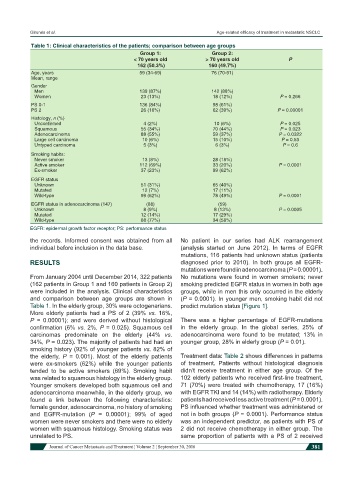Page 391 - Read Online
P. 391
Gironés et al. Age-related efficacy of treatment in metastatic NSCLC
Table 1: Clinical characteristics of the patients; comparison between age groups
Group 1: Group 2:
< 70 years old > 70 years old P
162 (50.3%) 160 (49.7%)
Age, years 59 (34-69) 76 (70-91)
Mean, range
Gender
Men 139 (87%) 142 (88%)
Women 23 (13%) 18 (12%) P = 0.266
PS 0-1 136 (84%) 98 (61%)
PS 2 26 (16%) 62 (39%) P = 0.00001
Histology, n (%)
Unconfirmed 4 (2%) 10 (6%) P = 0.025
Squamous 55 (34%) 70 (44%) P = 0.023
Adenocarcinoma 88 (55%) 59 (37%) P = 0.0322
Large cell carcinoma 10 (6%) 15 (10%) P = 0.53
Untyped carcinoma 5 (3%) 6 (3%) P = 0.6
Smoking habits:
Never smoker 13 (8%) 28 (18%)
Active smoker 112 (69%) 33 (20%) P = 0.0001
Ex-smoker 37 (23%) 99 (62%)
EGFR status
Unknown 51 (31%) 65 (40%)
Mutated 12 (7%) 17 (11%)
Wild-type 99 (62%) 78 (49%) P = 0.0001
EGFR status in adenocarcinoma (147) (88) (59)
Unknown 8 (9%) 8 (13%) P = 0.0005
Mutated 12 (14%) 17 (29%)
Wild-type 68 (77%) 34 (58%)
EGFR: epidermal growth factor receptor; PS: performance status
the records. Informed consent was obtained from all No patient in our series had ALK rearrangement
individual before inclusion in the data base. (analysis started on June 2012). In terms of EGFR
mutations, 116 patients had unknown status (patients
RESULTS diagnosed prior to 2010). In both groups all EGFR-
mutations were found in adenocarcinoma (P = 0.00001).
From January 2004 until December 2014, 322 patients No mutations were found in women smokers; never
(162 patients in Group 1 and 160 patients in Group 2) smoking predicted EGFR status in women in both age
were included in the analysis. Clinical characteristics groups, while in men this only occurred in the elderly
and comparison between age groups are shown in (P = 0.0001). In younger men, smoking habit did not
Table 1. In the elderly group, 30% were octogenarians. predict mutation status [Figure 1].
More elderly patients had a PS of 2 (39% vs. 16%,
P = 0.00001); and were derived without histological There was a higher percentage of EGFR-mutations
confirmation (6% vs. 2%, P = 0.025). Squamous cell in the elderly group. In the global series, 25% of
carcinomas predominate on the elderly (44% vs. adenocarcinoma were found to be mutated; 13% in
34%, P = 0.023). The majority of patients had had an younger group, 28% in elderly group (P = 0.01).
smoking history (92% of younger patients vs. 82% of
the elderly, P = 0.001). Most of the elderly patients Treatment data: Table 2 shows differences in patterns
were ex-smokers (62%) while the younger patients of treatment. Patients without histological diagnosis
tended to be active smokers (69%). Smoking habit didn’t receive treatment in either age group. Of the
was related to squamous histology in the elderly group. 102 elderly patients who received first-line treatment,
Younger smokers developed both squamous cell and 71 (70%) were treated with chemotherapy, 17 (16%)
adenocarcinoma meanwhile, in the elderly group, we with EGFR TKI and 14 (14%) with radiotherapy. Elderly
found a link between the following characteristics: patients had received less active treatment (P = 0.0001).
female gender, adenocarcinoma, no history of smoking PS influenced whether treatment was administered or
and EGFR-mutation (P = 0.00001); 99% of aged not in both groups (P = 0.0001). Performance status
women were never smokers and there were no elderly was an independent predictor, as patients with PS of
women with squamous histology. Smoking status was 2 did not receive chemotherapy in either group. The
unrelated to PS. same proportion of patients with a PS of 2 received
Journal of Cancer Metastasis and Treatment ¦ Volume 2 ¦ September 30, 2016 381

